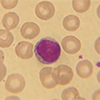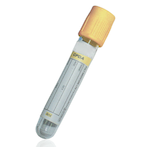Growth Hormone (GH)
Specimen Volume
1 mL of blood (Absolute minimum is 0.3 mL serum)Specimen Transport
Usual transport to laboratory.Sample Preparation
Turnaround Time
3 working daysSample Processing In Laboratory
Centrifuge and separate serum, store at fridge temperature prior to analysis..Sample Stability
Separated serum is stable for up to 21 days at room temperature (15-25°C), 18 days in the fridge (2-8°C) or 28 days frozen (-20°C) - freeze only once.General Information
Human growth hormone (hGH, somatotropin) is a polypeptide originating in the anterior pituitary. It is 191 amino acids in length and has a molecular mass of approximately 22 kDa. Its metabolic effects are primarily anabolic. It promotes protein conservation and engages a wide range of mechanisms for protein synthesis. It also enhances glucose transport and facilitates the buildup of glycogen stores.
Measurement of GH is primarily of interest in the diagnosis and treatment of various forms of inappropriate growth hormone secretion. Clinical disorders of hyposecretion include dwarfism and unattained growth potential. Hypersecretion is associated with gigantism and acromegaly.
Caution must be exercised in the clinical interpretation of growth hormone levels. These vary throughout the day, making it difficult to define a reference range or to judge an individuals status based on single determinations. Many factors are known to influence the rate of growth hormone secretion, including periods of sleep and wakefulness, exercise, stress, hypoglycaemia, oestogens, corticosteroids, L-dopa and others. Therefore, measurement of GH under random conditions is generally not of value. GH measurements are best dones as part of dynamic tests that involve pharmacological or physiological stimuli for release or suppression of GH.
The effects of GH on cartilage and on linear growth are mediated by other factors, known as somatomedins or insulin-like growth factors (IGFs). The most important of these is IGF-1. Serum levels of IGF-1 are fairly constant and a single measurement of IGF-1 can be considered an accurate reflection of IGF-1 production. Plasma levels of IGF-1 are increased in acromegaly and are reduced in GH deficiency and in many other forms of growth retardation.
Patient Preparation
For a single random sample, fast the patient overnight and collect the blood sample while the patient is resting and unstressed. For dynamic function tests the patient should be fasted overnight and sampling commence between 9am and 10am. Repetitive sampling should be via an indwelling venous catheter inserted 30 minutes before the commencement of the test. Dynamic function tests may be dangerous and should always be carried out under medical supervision. The assay is affected by pegvisomant (a highly selective GH receptor antagonist) and is therefore not suitable for patients under pegvisomant treatment. There is no interference with Octreotide (somatostatin analogue) or Cabergoline (dopamine agonist). The assay is not suitable for the determination of GH in samples from pregnant women. This is due to cross-reactivity to placental hGH. Placental GH is a variant of pituitary hGH36 and its serum levels increase during the course of pregnancy. Samples from patients receiving high biotin doses (i.e. >5 mg/day) should be taken at least 8 hours post dose. In rare cases, interference due to extremely high titres of antibodies to analyte‑specific antibodies, streptavidin or ruthenium can occur. These effects are minimized by suitable test design.
Notes
GH secretion is pulsatile and random samples are of little diagnostic value. IGF-1 can be used to investigate for GH deficiency. GH testing is usually provocative, using either a GH stimulation test or a GH suppression test to track GH levels over time. A series of specimens for GH may also be sent, as part of a “Dynamic function test” (DFT), for investigation of GH excess or deficiency. For QEHB patients, a glucose tolerance test (GH suppression test) or an insulin-induced hypoglycaemia test (GH stimulation test), should include concurrent estimations of plasma glucose. Therefore blood samples should be collected into a fluoride oxalate vacutainer as well as a SST/ red topped vacutainer at each time point. For other DFT’s such as Glucagon and Clonidine tests, blood should be collected into a (SST) or red topped vacutainer and allowed to clot at room temperature.
Reference Range
No reference range for Growth Hormone is quoted, as levels can depend upon the time of day, medication and exercise.
Specifications
-
EQA Status:
NEQAS
- EQAS Scheme: Yes








